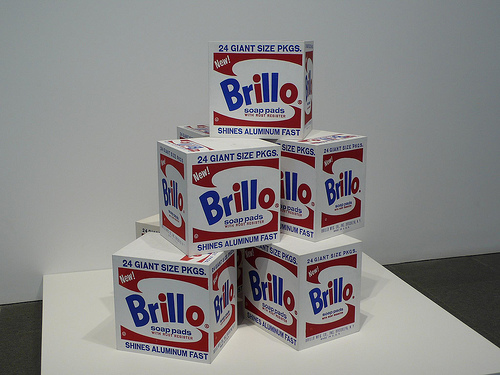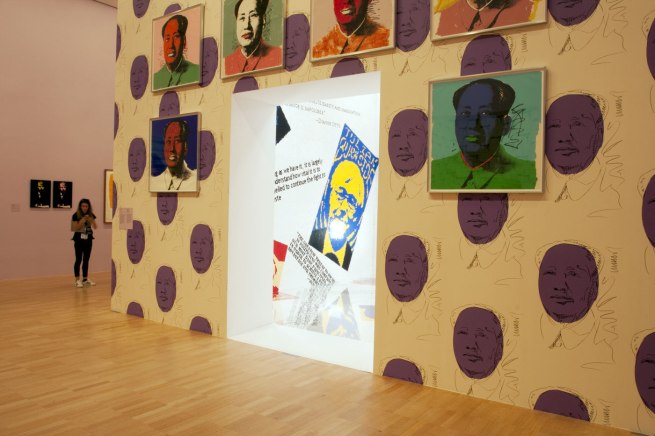 |
| Andy Warhol, Shadows, 1978-79 |
Not another Warhol exhibition! I was
surprised when the Musée d’Art Moderne de la Ville de Paris announced that its
major winter exhibition would be yet another Warhol extravaganza. I assumed I
didn’t need to go, as I often do when there is an exhibition of an artist’s
work that I have seen over and over again. I left it until its final week to
visit. And then, of course, the exhibition was filled with surprises and a
million reasons to see more Andy Warhol, yet again.
 |
| Andy Warhol, Shadows, 1978-79 |
The exhibition celebrates the first ever
European installation of Shadows (1978-79),
and fittingly focuses on a small, but important, selection of Warhol’s series. Shadows, a single work of 102 canvases,
the same abstract shadow ricocheting around the curve of the Museum’s main
gallery space, each canvas instance in a different colour scheme, reminds the
museum (according to the exhibition pamphlet) of individual film frames. The
relations between Warhol’s serial screen prints and film strips is no
revelation. Indeed, this relationship has often been remarked on. What’s more
interesting than the film/painting relationship--and rarely discussed--is the
romanticism and painterliness of his work. Shadows
presents a particularly outstanding example of this. Of course, it’s not
Abstract Expressionist, but neither is Warhol’s painting the factory produced
or reproducible object that undiscerning critics make it out to be. Warhol’s
reference points may be mass production, commercialism, the press, political
and social violence, but the texture of paint on a canvas is as rich and
sometimes dense as that of his contemporaries, such as Franz Kline or Clifford
Styll. There is always movement and depth on and within the Warhol canvas. I was
struck by this texture, thus the variability between canvases in the 102 Shadows. This work has nothing to do
with sameness, flatness, predictability or ease of comprehension. It’s abstract
and troubling.
 |
| Andy Warhol, Screen Tests in exhibition |
The exhibition of the Screen Tests here is innovative, but predictably, disappointing.
These four minute treasures from 1964 are rarely satisfying when seen in a
museum because they were not made to be exhibited in this way. At the Musée
d’Art Moderne, multiple screens create an architectural space inside which we
stand, always distracted by the screen on our right or left as we try to focus
on the one in front of us. I still think the most satisfying display of the Screen Tests is found in my avant-garde
and experimental film seminar: one after the other, in a small, intimate
blackened out room, in silence. Watching them in this way is revelatory. As we
focus on the one image for four minutes the personality of the sitter comes
alive: who can forget Anne Buchanan’s tear, Lou Reed and the coke bottle, Mario
Banana and the banana? We need to watch them from beginning to end,
concentrating, to be with the personality as it emerges across four minutes.
Blow
Job, a 35 minute film, shot and shown here on 16mm,
is placed in the middle of the Screen
Tests, a curatorial decision that completely confuses visitors, I would
have thought. The museum insists that the DVD transfers of the Screen Tests must be seen as
reproductions, thereby acknowledging the impoverishment of the images we see. And
yet, they place Blow Job in the
middle of the tests without mentioning its differences. My purist demands
aside, it’s great to see some of the tests that have not been published on DVD
- Duchamp, Ondine, Bob Dylan, Artaud, Mario Banana. Seeing them in the context
of Warhol’s larger project, immediately following a room devoted to
self-portraits, I was impressed by the transparency of these works as
collaborations. They are portraits based on a close collaboration, even if the
collaboration happened by accident. Warhol’s involvement is clearly marked by
the use of framing, distance, lighting, and color. And then, given four minutes
to behave in front of the camera as they choose to, the subjects are given the
responsibility of the performance.
 |
| Andy Warhol, Sixteen Jackies, 1964 |
Walking around, I was also struck by how
much of the exhibition is, in so many ways about death, destruction. In turn,
both are equated with the press. The Jackie Kennedy series is divine: glamour,
death and petition. The unpredictability of the silk screen process: varying,
saturation, uneven inking, makes each one different, each Jackie more poignant
than the previous one. She, like Marilyn, and curiously connected to Mao and
Elvis are slaughtered by the press even as they are celebrated. The Richter
connection is obvious: he too made portraits of Jackie, at about the same time.
Both artists make portraits that are beautiful, mysterious, and deeply saddened
by the fetishization of an icon.
 |
| Andy Warhol, Brillo Boxes, 1969 |
As I say, the exhibition opens with a room
of self-portraits. Warhol needed to represent himself repeatedly. It was how he
would find out: who am I? The personality of the artist is the title of the Brillo
boxes exhibition at the Stable Gallery in New York in 1964. Each one is
different, lovingly made. Again, they may refer to mass production, but each is
hand made, and each then each box becomes a portrait. After the Brillo boxes, a
whole room, in its entirety is a portrait of Mao. Mao represents “The Cult of
the Personality” which takes on a whole new meaning after Warhol, because of
Warhol, and Mao as he is seen by Warhol. Mao is everywhere and everyone in this
room: wall paper, portraits, overpainting, portraits defaced, made beautiful,
he smiles, scowls, has a myriad different expressions because of the
overpainting, the manipulation, the painterly touches that are anything but
mass produced.
 |
| Andy Warhol, Chairman Mao, 1972-73 |
I came away from the exhibition feeling very
nostalgic for the 60s, a time when it was possible to create, to explore ideas
and take risks, without today’s urgent imperative to make money from one’s art
in order to succeed. I looked on with a kind of longing for the days of The
Factory (or La Factory as they call it in French!), for a time when it was
still possible to have a place in mid-town Manhattan, where things really
happened, and the institutions and commerces in the midst embraced the extreme,
the blue skies romantic ideals of young artists. Today, the Warhols and his
hangers-on are all priced out of Manhattan, out of risk and experimentation.
Warhol changed the definition and limits of
art irrevocably. Indeed, this exhibition makes us aware, it’s because it was
the 60s that such radical transformation could happen. I was bemoaning the loss
of such inspiration today, and nostalgically yearning for the complications of
creative possibility to a friend of my generation. He quickly reminded me that
it’s because of Warhol that art is a commercial business today. We live in a
world where different demands are made on art, to the point that the immense risk
and vast scale of Warhol’s oeuvre could never happen today; it is a phenomenon
of the 60s. And in the ultimate irony? It’s because of Warhol that what Warhol
did is no longer possible today.
No comments:
Post a Comment